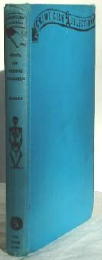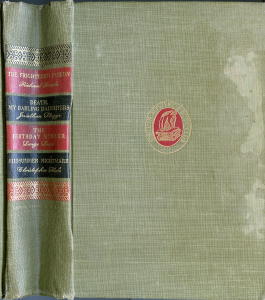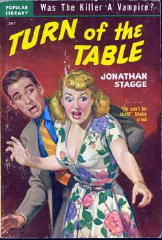Fri 4 Apr 2008
Review: JONATHAN STAGGE – Death, My Darling Daughters.
Posted by Steve under Authors , Bibliographies, Lists & Checklists , Crime Fiction IV , Reviews[4] Comments
JONATHAN STAGGE – Death, My Darling Daughters.
Unicorn Book Club; hardcover reprint, June 1946. Hardcover first edition: Doubleday Crime Club, 1945. UK hardcover: Michael Joseph, as Death and the Dear Girls, 1946. Digest paperback reprint: Bestseller Mystery #B164; no date stated but circa 1953.

Most of my time this week has been spent on doing my taxes, which are now done, at last. In the meantime, I’ve posted some old reviews to keep you from stopping by and seeing nothing new. I haven’t chosen the last two at random, though. I had a small design in mind, with no further explanation. I’ll let you put two and two together on your own.
Jonathan Stagge was the author of nine mysteries published under Doubleday’s Crime Club imprint between 1937 and 1949. Each of these book featuring a country doctor by the name of Dr. Hugh Westlake as their leading sleuth. A widower, he lived with his daughter Dawn, who had only incidental roles in the cases he solved — I think. Maybe I’m wrong on that, as I’ve only read two or three of them, and none toward the end of the series, where she may have not appeared at all. And in some of the earlier ones, read a long time ago, she may have had more a part to play than she does in Death, My Darling Daughters.
If you’ve been following me as I’ve gone along, however, you won’t be surprised to learn that Jonathan Stagge was a pen name and not a real person. He was instead the writing combo of Richard Wilson Webb and Hugh Callingham Wheeler, who also wrote at various times as Patrick Quentin and Q. Patrick. (Later on in his career, Wheeler co-wrote a play with Stephen Sondheim called Sweeney Todd, the Demon Barber of Fleet Street. I didn’t know that, until just now.)
It’s not clear how old Dawn is when the book at hand begins. Westlake calls her “my young daughter,” and mentions that he had moved with her to the small Massachusetts town of Kenmore after his wife’s death ten years earlier. Dawn is therefore old enough to be left alone in their home for long periods of time, but young enough to naively point out (and strongly suggest) women who might make good wives for him.
New in town, or rather newly back in town, is the family descended of one of Kenmore’s more famous citizens, Benjamin Hilton, who at one time was the Vice President of United States. (One of the more obscure ones, you may be sure.) Dawn is the reason that Dr. Westlake gets to meet the family, a mother and two daughters, all rather standoffish from the rest of the town’s inhabitants, but it’s the death of their aged nanny that gets him involved with their problems in his other capacity of town coroner.

And when the other branches of the family come to visit, both headed by famous research doctors, it is Inspector Cobb, whom Westlake has assisted before, who asks him to stay underfoot and see what he can learn. They suspect murder, but the local D.A. is wisely afraid of annoying such important people.
And when a second death occurs, they know they’re right, and the D.A. wrong. There is a sense of slyly malicious humor involved in Stagge’s telling of the tale, but even though this is nearly the equivalent of English manor house mystery, with only a very few suspects living together under one roof, the fact is that the people are all very unlikeable. (Some more than others.)
It slows the reading down, this small fact does, but it is important. The daughters, both in their late teens or early 20s, have been sexually repressed by their mother, in the good old Puritan tradition. Nor are their aunts of much assistance, both rather weak and futile creatures. The two men in the family are greedy and overbearing, along with any other faults that you think might apply to the stuffy male aristocracy of New England.
Dr. Westlake has the very desirable trait of allowing nearly perfect strangers tell him their life histories, which certainly eases the way when his sleuthing hat is on. Nonetheless, as the book begins to close, and you (the reader) are starting to wonder if there is any real puzzle to be solved, the answer I’m going to be ambiguous and say only that persevering to the end usually pays off.
Overall? There are some dull spots in the reading — and looking back, I can’t see any way the author could have avoided them, or not easily — but there’s enough solid substance here to give the book a thumbs up. But two of them? I’ve thought it over, and the answer is no, as much I’d like to, I just can’t do it.
[ADDED LATER.] Using Al Hubin’s Crime Fiction IV as a guide, here’s a list of all the Jonathan Stagge books, in chronological order:
The Dogs Do Bark. Doubleday 1937 [Dr. Hugh Westlake; Pennsylvania]
Murder by Prescription. Doubleday 1938 [Dr. Hugh Westlake; Pennsylvania]
The Stars Spell Death. Doubleday 1939 [Dr. Hugh Westlake; Pennsylvania]
Turn of the Table. Doubleday 1940 [Dr. Hugh Westlake; Pennsylvania]

The Yellow Taxi. Doubleday 1942 [Dr. Hugh Westlake; Pennsylvania]
The Scarlet Circle. Doubleday 1943 [Dr. Hugh Westlake; New England]

Death, My Darling Daughters. Doubleday 1945 [Dr. Hugh Westlake; Massachusetts]
Death’s Old Sweet Song. Doubleday 1946 [Dr. Hugh Westlake; Massachusetts]
The Three Fears. Doubleday 1949 [Dr. Hugh Westlake; Massachusetts]
April 5th, 2008 at 9:57 am
It’s interesting to learn more about the work of Stagge/Patrick/Quentin. If memory serves, Wheeler also wrote the very successful A Little Night Music.
April 5th, 2008 at 10:17 am
Right you are! He was obviously extremely talented as a writer. Writing mysteries was not his only forte. From the Internet Broadway Database:
Hugh Wheeler
( b. Mar 19, 1912 – d. Jul 26, 1987 ) Male
Writer, Composer
Also known as:
Patrick Quentin
Productions Dates of Production
Sweeney Todd [Revival, Musical, Thriller]
Book by Hugh Wheeler
Nov 3, 2005 – Sep 3, 2006
Pacific Overtures [Revival, Musical, Comedy, Drama]
Additional Material by Hugh Wheeler
Dec 2, 2004 – Jan 30, 2005
Candide [Revival, Musical, Comedy]
Adapted from Voltaire by Hugh Wheeler
Apr 29, 1997 – Jul 27, 1997
Meet Me in St. Louis [Original, Musical, Comedy]
Book by Hugh Wheeler
Nov 2, 1989 – Jun 10, 1990
Sweeney Todd [Revival, Musical, Thriller]
Book by Hugh Wheeler
Sep 14, 1989 – Feb 25, 1990
The Little Prince and the Aviator [Original, Musical]
Book by Hugh Wheeler
Never offically opened – Jan 17, 1982
Sweeney Todd [Original, Musical, Thriller]
Book by Hugh Wheeler
Mar 1, 1979 – Jun 29, 1980
Pacific Overtures [Original, Musical, Comedy, Drama]
Additional material by Hugh Wheeler
Jan 11, 1976 – Jun 27, 1976
Truckload [Original, Musical]
Book by Hugh Wheeler
Never offically opened – Sep 11, 1975
Love for Love [Revival, Play]
Songs by Hugh Wheeler
Nov 11, 1974 – Nov 30, 1974
Candide [Revival, Musical, Comedy]
Book adapted by Hugh Wheeler
Mar 10, 1974 – Jan 4, 1976
Irene [Revival, Musical, Comedy]
Book by Hugh Wheeler
Mar 13, 1973 – Sep 8, 1974
A Little Night Music [Original, Musical, Romantic Comedy]
Book by Hugh Wheeler
Feb 25, 1973 – Aug 3, 1974
We Have Always Lived in the Castle [Original, Play]
Written by Hugh Wheeler
Oct 19, 1966 – Oct 26, 1966
Look, We’ve Come Through [Original, Play]
Written by Hugh Wheeler
Oct 25, 1961 – Oct 28, 1961
Big Fish, Little Fish [Original, Play, Comedy]
Written by Hugh Wheeler
Most fascinating!
April 5th, 2008 at 10:29 am
My review of the book, for those interested:
http://gadetection.pbwiki.com/Death%2C+My+Darling+Daughters
April 5th, 2008 at 11:10 am
Thanks, Xavier. An excellent review! Not that we agree in all respects. You describe the characters as “well-portrayed, engaging.” I called them “unlikeable.”
But do you know what? And this isn’t going to make any sense to anyone who’s not read the book. I think we’re both right.
— Steve